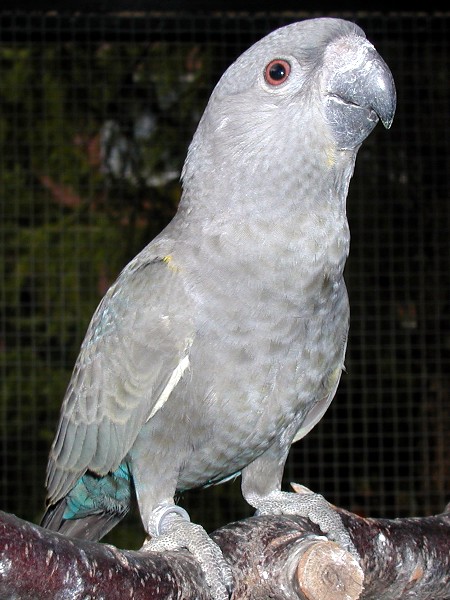RÞppell's parrot on:
[Wikipedia]
[Google]
[Amazon]
RÞppell's parrot (''Poicephalus rueppellii'') or Rueppell's parrot, is a bird that is endemic to southwestern

 RÞppell's parrot is 22â25 cm (9 in) long and weighs 121â156 g. It has an overall dark brown color and its head is dark greyish. Both adult male and female birds have some yellow feathers on the leading edge of the wings, and yellow feathers covering their upper legs; in immature birds, the yellow is dull or missing. They are
RÞppell's parrot is 22â25 cm (9 in) long and weighs 121â156 g. It has an overall dark brown color and its head is dark greyish. Both adult male and female birds have some yellow feathers on the leading edge of the wings, and yellow feathers covering their upper legs; in immature birds, the yellow is dull or missing. They are
Photograph on CITES website
*Richard G. Selman, Mike R. Perrin, Margaret L. Hunter & W.R.J. Dean (2002) The feeding ecology of RÞppell's Parrot, Poicephalus rueppellii, in the Waterberg, Namibia, Ostrich, 73:3-4, 127â134, DOI: 10.1080/00306525.2002.11446741
Species text in The Atlas of Southern African Birds
{{Taxonbar, from=Q640376 RÞppell's parrot Birds of Southern Africa RÞppell's parrot RÞppell's parrot
Africa
Africa is the world's second-largest and second-most populous continent, after Asia in both cases. At about 30.3 million km2 (11.7 million square miles) including adjacent islands, it covers 6% of Earth's total surface area ...
from central Namibia
Namibia (, ), officially the Republic of Namibia, is a country in Southern Africa. Its western border is the Atlantic Ocean. It shares land borders with Zambia and Angola to the north, Botswana to the east and South Africa to the south and ea ...
to southwest Angola
, national_anthem = " Angola Avante"()
, image_map =
, map_caption =
, capital = Luanda
, religion =
, religion_year = 2020
, religion_ref =
, coordina ...
. It lives in savanna
A savanna or savannah is a mixed woodland- grassland (i.e. grassy woodland) ecosystem characterised by the trees being sufficiently widely spaced so that the canopy does not close. The open canopy allows sufficient light to reach the ground to ...
where there are trees or in dry woodland. It is more common near streams or rivers. The name commemorates the German naturalist and explorer Eduard RÞppell.
Description

 RÞppell's parrot is 22â25 cm (9 in) long and weighs 121â156 g. It has an overall dark brown color and its head is dark greyish. Both adult male and female birds have some yellow feathers on the leading edge of the wings, and yellow feathers covering their upper legs; in immature birds, the yellow is dull or missing. They are
RÞppell's parrot is 22â25 cm (9 in) long and weighs 121â156 g. It has an overall dark brown color and its head is dark greyish. Both adult male and female birds have some yellow feathers on the leading edge of the wings, and yellow feathers covering their upper legs; in immature birds, the yellow is dull or missing. They are sexually dimorphic
Sexual dimorphism is the condition where the sexes of the same animal and/or plant species exhibit different morphological characteristics, particularly characteristics not directly involved in reproduction. The condition occurs in most ani ...
; adult female birds have blue feathers on the lower back and the rump, whilst male birds lose this blue feather coloration as they become mature.
Diet
The Ruppell's Parrot eats mainly seeds, flowers, leaves, anthropods, and bark. It has been found that during the rainy seasons they prefer to eat flowers and insects. Consistently they eat Terminalia pruniodies (T. pruniodies) and occasionally they also eat fruit, preferring softer more tender ones.Breeding
The RÞppell's parrot nests in tree cavities. The eggs are white and there are usually three or four in a clutch. The female incubates the eggs for about 28 days and the chicks leave the nest about 68 days after hatching.Status
It is a protected species, listed onCITES
CITES (shorter name for the Convention on International Trade in Endangered Species of Wild Fauna and Flora, also known as the Washington Convention) is a multilateral treaty to protect endangered plants and animals from the threats of interna ...
appendix II.
References
* del Hoyo, J., et al., eds. (1997). '' Handbook of the Birds of the World'' 4: 415. Lynx Edicions.Photograph on CITES website
*Richard G. Selman, Mike R. Perrin, Margaret L. Hunter & W.R.J. Dean (2002) The feeding ecology of RÞppell's Parrot, Poicephalus rueppellii, in the Waterberg, Namibia, Ostrich, 73:3-4, 127â134, DOI: 10.1080/00306525.2002.11446741
External links
* RÞppell's parrot âSpecies text in The Atlas of Southern African Birds
{{Taxonbar, from=Q640376 RÞppell's parrot Birds of Southern Africa RÞppell's parrot RÞppell's parrot